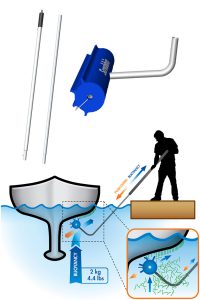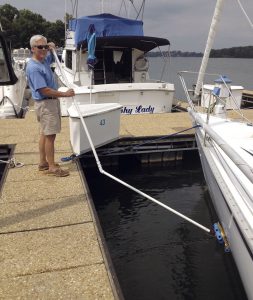 HATCH TENT HELP
HATCH TENT HELP
Thank you for the article on the hatch tent. The one shown would certainly keep the rain out. However, when we are at anchor we need to have quick access to the bow and a tent design inhibits that. I’ve been looking for a compact, free-standing design, but those that are commercially available are way too expensive. I’ve considered using a pet- or child-size dome tent with part of the bottom cut out. Any experience or thoughts about that idea?
–Brian McMahon, Windchaser
We don’t have any experience in this realm. For the past eight years, we’ve closed our hatches when the rain comes (and in the Tropics we’ve often suffered for it, at night especially, but that rain is usually short-lived). If any readers have advice to offer Brian, please contact him directly at: vulcan213@gmail.com
 DIY BOTTOM CLEANING FROM THE DOCK?
DIY BOTTOM CLEANING FROM THE DOCK?
Last month, I put it to the readers about whether you’ve tried one of the stay-dry-and-clean-your-boat-bottom-from-the-dock tools, you know, one of those brushes on a long handle. I shared how I personally spent a couple of years in my 20s underwater, cleaning boat bottoms and that I’ve long been skeptical of these easy-as-pie DIY tools, I just didn’t see how they could substitute for a diver. But Davis had just released their own version of these things, called Scrubbis (pictured) and I wanted to get opinions from folks who’ve actually used one of these. I have to say that I expected first-hand stories that would support my skepticism, but received none. Here is what some of you had to say.
I originally bought my “hull of a brush” kit (company no longer around) to keep the bottom of my J/27 clean for club racing. It’s an awesome tool and I still have it, and still use it. The secret was using the right interchangeable bent shafts to match the hull contour, then scrub and feel my way along the keel, the hull, and the rudder. It’s very effective, even on the full keel of my Cape Dory Typhoon and the fin keel of my Catalina 27. I wish the company was still in business; I’d buy this for friends.
–Jeff Urquhart, Huntington, New York
The owner of a 30-foot custom sloop I crewed on used a homemade device like Davis’ made from 2-inch PVC pipe. It was buoyant. And the cross piece that scrubbed the bottom was covered with indoor-outdoor carpet. It worked well for light scrubbing before a race.
–Kevin Hendricks, Catalina 380, Oso del Mar, Sausalito, California
For about three years, I’ve been using my Scrubbis and I am very happy with it. It requires a little trial and error to figure out how to use it, but once I got the hang of it, I was very pleased with the results. The lake we keep our boat on (Oologah Lake, 30 miles north of Tulsa, Oklahoma) has visibility of less than 6 feet, so you can guess how quickly our bottoms become fouled.
I use the Scrubbis every month to keep the bottom clean. I will not claim that it does a perfect cleaning, especially of the fin keel of our 1982 Catalina 30, but it does a good enough job to effect a noticeable increase in speed (a knot or better) after the first cleaning, and regular use seems to maintain the increase.
The poles are easily assembled, and do not allow flexing that would weaken contact with the bottom; the positive buoyancy of the cleaning head keeps it in good contact with the hull surface. There is a stiff scraper on the Scrubbis head for scraping harder growths, but since we do not see much of that I cannot say how it works. The first time I used the Scrubbis, I got the head caught between the hull and the prop shaft, I gave it a quick pull and got just the pole out. The brush head floated to the surface on the other side of the boat and I reconnected it to the pole and continued on.
One time, I lent the Scrubbis to another sailor and he hit the paddlewheel for his knotmeter and took a chunk out of the Scrubbis (he found the chunk). He wanted to buy me a new one, but I simply put it back together with some 3M weather-strip adhesive and it is still going strong.
I have pulled the boat into shallow water and felt the bottom after a cleaning and was very pleased with the results. I still don’t know how well it does the keel, you just cannot see it. Does the Scrubbis deliver as good a cleaning as hand cleaning? Probably not, but it comes close.
–Rick Leach, Canigo Too
Forty years ago, I made a dock-side bottom scrubber by bolting a regular boating scrub brush to a ten-foot-long piece of hull-shape-curved one-inch-diameter aluminum tubing. I added flotation to the brush by fastening two closed cell foam pads from a used throwable cushion. The flotation provides just enough upward pressure to clean the bottom with just a bit of upward pressure added by me. I start at the stern and swath by swath I work my way to the bow. I can do the keel as well. The bottom of Rushwind (and the two Rushwinds before her) have been kept very clean using this method. I only recently changed the flotation and I am ready for a third replacement brush.
I use a hard copper bottom paint (Pettit Trinidad) and I routinely go three to five years between painting. A quick scrub right before a race was always beneficial.
–Kenelm Russell, Rushwind, Fast Passage 39, Olympia, Washington
 Oh yeah, I’ve cleaned the hull many times, many ways, but my favored solution is described in the article I wrote for Good Old Boat magazine (“Homemade Bottom Cleaner,” July 2013).
Oh yeah, I’ve cleaned the hull many times, many ways, but my favored solution is described in the article I wrote for Good Old Boat magazine (“Homemade Bottom Cleaner,” July 2013).
–Ferman Wardell, Charlotte, North Carolina


